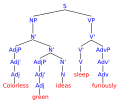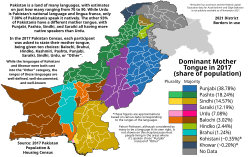manipulation of formal languages in this way. The field of formal language theory studies primarily the purely syntactic aspects of such languages—that is, their...
27 KB (3,163 words) - 02:41, 1 May 2025
a pattern language is a formal language that can be defined as the set of all particular instances of a string of constants and variables. Pattern Languages...
15 KB (1,261 words) - 06:53, 22 July 2024
concept pattern language (see above) Pattern language (formal languages), a class of strings generated from a pattern by substitutions, in formal language theory...
575 bytes (110 words) - 20:00, 5 February 2023
formal semantics. Its types and pattern matching make it well-suited and commonly used to operate on other formal languages, such as in compiler writing...
13 KB (1,461 words) - 18:17, 29 April 2025
B (concatenation) are regular languages. No other languages over Σ are regular. See Regular expression § Formal language theory for syntax and semantics...
29 KB (3,424 words) - 23:25, 20 April 2025
SNOBOL (redirect from SNOBOL programming language)
SNOBOL ("StriNg Oriented and symBOlic Language") is a series of programming languages developed between 1962 and 1967 at AT&T Bell Laboratories by David...
22 KB (2,578 words) - 14:41, 16 March 2025
needed] Patterns that imply mutable state may be unsuited for functional programming languages. Some patterns can be rendered unnecessary in languages that...
47 KB (3,181 words) - 12:37, 24 April 2025
formal language theory and pattern matching, alternation is the union of two sets of strings, or equivalently the logical disjunction of two patterns...
3 KB (285 words) - 20:53, 11 November 2021
maintainability issues, as these languages were not originally designed with OOP in mind. In the new millenium, new languages like Python and Ruby have emerged...
67 KB (7,159 words) - 00:55, 20 April 2025
Syntax (logic) (redirect from Syntax (formal languages))
marks or a metalanguage of marks which form a particular pattern. Symbols of a formal language need not be symbols of anything. For instance there are...
10 KB (1,052 words) - 03:58, 6 March 2025
their syntax (form) and semantics (meaning), usually defined by a formal language. Languages usually provide features such as a type system, variables, and...
65 KB (7,416 words) - 06:14, 1 May 2025
languages, and are the basis for the advanced pattern sub-language being defined in SQL/PGQ, which is likely to become a subset of the GQL language....
37 KB (4,272 words) - 10:42, 5 January 2025
Sino-Tibetan languages. Burmese is the most widely spoken of the non-Sinitic Sino-Tibetan languages. Burmese was the fifth of the Sino-Tibetan languages to develop...
105 KB (10,033 words) - 03:03, 6 April 2025
formalized natural languages, such as Gellish. Gellish has natural language variants such as Gellish Formal English and Gellish Formal Dutch (Gellish Formeel...
23 KB (2,902 words) - 14:18, 4 April 2025
programming languages. In 1980, statistical approaches were explored and found to be more useful for many purposes than rule-based formal grammars. Discrete...
16 KB (2,382 words) - 00:06, 17 April 2025
kind of language, and include domain-specific markup languages, domain-specific modeling languages (more generally, specification languages), and domain-specific...
32 KB (3,827 words) - 18:54, 16 April 2025
Canaanite group of languages. Canaanite languages are a branch of the Northwest Semitic family of languages. Hebrew was the spoken language in the Iron Age...
112 KB (11,591 words) - 17:28, 28 April 2025
transcription delimiters. The Romance languages, also known as the Latin or Neo-Latin languages, are the languages that are directly descended from Vulgar...
174 KB (16,618 words) - 15:14, 29 April 2025
top of the formal structure: There is in my opinion no important theoretical difference between natural languages and the artificial languages of logicians;...
4 KB (494 words) - 22:24, 25 January 2025
Chomsky hierarchy (redirect from Hierarchy of Language Classes)
in the development of the theory of formal languages; the paper "The algebraic theory of context free languages" describes the modern hierarchy, including...
12 KB (1,349 words) - 18:45, 15 March 2025
Literary language is the register of a language used when writing in a formal, academic, or particularly polite tone; when speaking or writing in such...
34 KB (4,376 words) - 15:47, 7 April 2025
Substring (redirect from Prefix (formal languages))
In formal language theory and computer science, a substring is a contiguous sequence of characters within a string.[citation needed] For instance, "the...
6 KB (833 words) - 00:04, 21 December 2023
it is the national language, and within the Japanese diaspora worldwide. The Japonic family also includes the Ryukyuan languages and the variously classified...
94 KB (10,869 words) - 09:35, 27 April 2025
the top four languages in the TIOBE index, a measure of the popularity of programming languages. C is an imperative, procedural language in the ALGOL...
101 KB (11,185 words) - 09:17, 1 May 2025
theory, induction of regular languages refers to the task of learning a formal description (e.g. grammar) of a regular language from a given set of example...
29 KB (3,294 words) - 22:56, 16 April 2025
over 70 languages spoken as first languages. The majority of Pakistan's languages belong to the Indo-Iranian group of the Indo-European language family...
60 KB (4,554 words) - 17:19, 26 April 2025
Maninke, Minyanka, Senufo, Songhay languages, Soninke and Tamasheq are official languages. French is the working language. In 2024, the Francophone population...
18 KB (1,170 words) - 13:57, 8 November 2024
Afroasiatic languages (also known as Afro-Asiatic, Afrasian, Hamito-Semitic, or Semito-Hamitic) are a language family (or "phylum") of about 400 languages spoken...
108 KB (10,961 words) - 02:03, 15 April 2025
Mama and papa (category Articles containing Arabic-language text)
Note that the usage of these words is at odds with the usage pattern in other languages (similar to Georgian in that sense). In Telugu, the common words...
29 KB (3,356 words) - 22:37, 30 April 2025
Functional programming (redirect from Functional languages)
but many functional languages are seeing use today in industry and education, including Common Lisp, Scheme, Clojure, Wolfram Language, Racket, Erlang, Elixir...
87 KB (8,696 words) - 20:51, 16 April 2025














